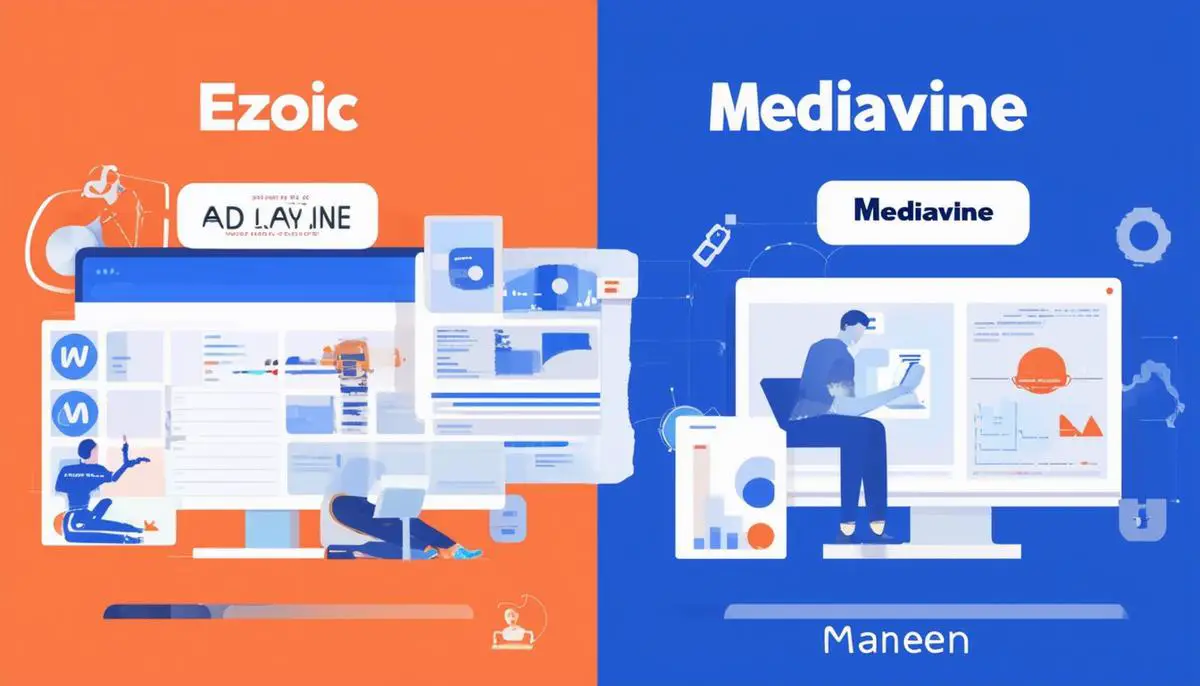Price and Revenue Sharing
Ezoic and Mediavine present distinct cost structures and revenue shares, impacting overall earnings.
Ezoic takes 10%, allowing publishers to keep 90% of ad revenue. This split makes it appealing to those looking to maximize earnings. Mediavine offers a 75/25 split, with publishers retaining 75%. Despite the higher cut, Mediavine's premium ad partnerships and potential high RPMs may justify the difference.
Ezoic's basic services can be used without charge—outside of an ad-funded tier—while advanced features, like Ezoic Premium, come with a subscription cost. Mediavine operates without direct fees but a 25% share in ad revenues can be more burdensome for smaller publishers.
Earnings per thousand visitors (EPMV) on Ezoic can vary. While publishers generally report a consistent increase in ad revenue, results hinge on traffic type and ad placements. In contrast, Mediavine often delivers higher RPMs due to a strong focus on high-quality, premium ads particularly effective in niches like food and parenting blogs.
Ezoic's Ezoic Premium and VIP program have special pricing tiers but offer higher returns on investment through better ads. Mediavine's revenue model is simpler but rigid, requiring publishers to comply with its high standards and exclusivity in display ad management, meaning they can't use other ad providers simultaneously.
Ezoic uses CPM and earnings per thousand visitors (EPMV), customized to optimize each page. Mediavine leans heavily on CPM, focusing on content quality and ad relevance, which can sometimes lead to higher revenues despite the steeper revenue cut.
By closely examining these financial aspects, publishers can better discern which platform aligns with their financial goals and website's monetization strategy.
Ad Layout Technology
Ezoic and Mediavine employ differing strategies and technologies to optimize ad layout and performance, each with unique strengths designed to improve user experience and maximize revenue for publishers.
Ezoic leverages advanced AI and machine learning algorithms to automatically test and optimize ad placements. Through continuous experimentation, Ezoic's AI dynamically adjusts ad positions, sizes, and formats based on user interactions and performance metrics. This approach ensures that the ads shown are the most profitable and least intrusive to visitors. Header bidding is another critical component of Ezoic's technology stack, allowing multiple ad exchanges to bid on the same inventory simultaneously. This bidding wars concept increases competition and often drives up CPMs, ensuring publishers receive the highest possible revenue for their ad space.
On the other hand, Mediavine offers a more curated ad experience with a strong emphasis on content quality and user experience. Mediavine employs dynamic ad placements, thoroughly tested for high viewability and relevance. This ensures ads blend seamlessly with the site's content and do not disrupt the user experience. Mediavine's optimization strategies also include header bidding and lazy loading technology, which helps improve page load times by loading ads only when they are about to enter the user's viewport. This approach helps to maintain fast site speeds—a key factor for user engagement and SEO performance.
Both platforms have their unique approaches to ad optimization. While Ezoic's AI-driven strategy provides a highly customizable and data-centric solution, Mediavine's selective ad placements cater more to niche-specific publishers, ensuring high-quality ads are displayed without sacrificing site performance. This difference in approach allows publishers to choose a platform that aligns best with their website's content style and monetization goals.

Publisher Experience and Support
Navigating the publisher experience and support systems is crucial when choosing between Ezoic and Mediavine. Both platforms offer robust tools and varying degrees of assistance, but key differences exist in ease of use, setup, support, and community engagement.
Ezoic emphasizes flexibility and autonomy, granting publishers the power to control and customize ad placements extensively. However, this flexibility often comes with a learning curve. The initial setup process, particularly if integrating via DNS settings, can be complex for those with limited technical knowledge. Ezoic aims to mitigate this complexity with a comprehensive array of tutorials, support articles, and video guides to walk users through their platform.
In terms of support, Ezoic provides multiple tiers that range from basic email and ticket-based assistance to premium, dedicated account managers for those in higher tiers or using Ezoic Premium. Additionally, Ezoic hosts an active community forum and a Facebook group where publishers can seek peer-to-peer assistance and share insights.
Mediavine, on the other hand, is a full-service platform designed for simplicity and user-friendliness. The setup process is streamlined, often requiring only the addition of a script wrapper to your site's code. For WordPress users, this integration is made even simpler through their plugin. Mediavine takes responsibility for placing and optimizing ads, which is particularly advantageous for publishers who prefer a hands-off approach.
Customer support is where Mediavine truly shines. Known for its responsiveness and high-quality service, Mediavine offers support via email and a comprehensive help center. Moreover, the platform prides itself on its thriving publisher community, particularly through its active Facebook group. This community is a valuable resource for publishers looking to gain insights, share experiences, and seek quick support from both peers and Mediavine staff.
In addition to customer support, Mediavine provides a range of tools aimed at enhancing both user experience and ad performance. Key offerings include their Trellis WordPress theme for optimized site speed and the Grow tool to boost user engagement through first-party data.
In summary, Ezoic offers a highly customizable experience that can be rewarding for those willing to navigate its intricacies. Alternatively, Mediavine provides a more streamlined, supportive environment, valuing simplicity and high-quality customer service. The choice between these platforms should be guided by the publisher's preferred level of control and the importance placed on community and support. Deploying either platform can significantly boost site monetization, but the path to that boost varies in terms of effort and support.
Website Performance and Page Speed Impact
Integrating an advertisement platform with your website can have significant impacts on page load speeds, a crucial factor in user experience and SEO performance. Let's explore how Ezoic and Mediavine address these performance considerations and what tools they deploy to mitigate any adverse impacts.
When it comes to Ezoic, the platform's AI-driven approach not only optimizes ad placements but also continuously monitors their impact on website performance. Ezoic's Leap, their performance optimization toolset, is designed to enhance site speed and ensure compliance with Google's Core Web Vitals. By focusing on elements that cause slower load times, Leap provides actionable insights and automated solutions to improve overall page performance.
However, it's essential to note that some publishers have reported initial slowdowns when integrating Ezoic. This typically happens as Ezoic's AI learns optimal placements, which can involve a temporary period of adjustment. To counteract potential performance dips, Ezoic offers a Site Speed Accelerator, which further refines the speed improvements initiated by Leap. Through CDN integration, image optimization, and lazy loading of ads, Ezoic works to minimize the performance impact and keep your site running smoothly.
Mediavine, on the other hand, places a high emphasis on maintaining fast load times from the get-go. Their strategy includes lazy loading technology, which ensures that ads only load when they are about to appear in the user's viewport. This method prevents ads from slowing down the initial page load, preserving a swift user experience. Mediavine's Trellis WordPress theme also plays a critical role in optimizing site performance. Trellis is specifically designed to meet and exceed Google's Core Web Vitals requirements, focusing on speed, loading efficiency, and user engagement. This theme ensures a solid foundation for both content and ads without compromising speed.
Given its premium nature, Mediavine provides more curated and controlled ad placements, which are rigorously tested for their impact on page speed. Mediavine's dedicated team monitors these performances regularly, ensuring that any negative impacts are quickly identified and rectified. This proactive approach ensures that the integration of ads does not detrimentally affect page load times, contributing to a seamless user experience that benefits both SEO and user satisfaction.
In summary, both Ezoic and Mediavine offer solutions to handle the intricacies of ad integration while prioritizing website performance. Ezoic's AI-driven optimizations and Leap toolset empower publishers with granular control and advanced analytics for continuous improvement in speed and performance. Mediavine's lazy loading technology and Trellis theme provide a stable, high-speed environment from the outset, along with ongoing support and adjustments to maintain peak performance. Each platform's strategies and tools are designed to mitigate the inherent challenges of integrating ads, ensuring that publishers can generate revenue without compromising on speed or user experience.
Traffic Requirements
Ezoic and Mediavine cater to publishers with differing traffic levels and session requirements, making their platforms accessible to various audience sizes and niches.
For Ezoic, the barrier to entry is significantly lower. Ezoic welcomes websites with as little as 10,000 monthly visitors, making it an attractive option for smaller publishers or those just starting. This inclusivity extends to a wide range of niches, allowing diverse content to benefit from Ezoic's ad optimization technologies. The absence of stringent traffic prerequisites ensures that even burgeoning sites can leverage Ezoic's tools to enhance their ad revenue and site performance.
Conversely, Mediavine sets higher traffic requirements, focusing on established publishers with substantial audience engagement. To join Mediavine, a site must accumulate at least 50,000 sessions per month, which roughly translates to about 70,000 page views. This criterion ensures that only websites with consistent and significant traffic volumes can access the premium ad services Mediavine offers. Additionally, Mediavine places a strong emphasis on niche specificity. It is particularly beneficial for publishers in the following niches:
- Lifestyle
- Food
- Travel
- Parenting
- Finance
These niches tend to attract high-quality ads with potentially higher RPMs. However, the higher entry threshold can pose challenges for smaller publishers or those in less popular niches.
The implications of these traffic requirements are profound for publishers of varying sizes. Ezoic's low threshold means new and smaller publishers can start monetizing their content early, gaining valuable insights and gradually increasing their revenue as their audience grows. For larger publishers, Ezoic provides sophisticated tools and customizable options necessary for advanced monetization strategies without the need for extensive pre-existing traffic.
Mediavine's requirements, while more restrictive, justify their high performance and premium ad partnerships. Publishers meeting Mediavine's criteria often experience higher revenues, thanks to the quality and relevance of ads displayed. However, the exclusivity agreement means they must fully commit to Mediavine for ad management, limiting flexibility but ensuring focused and optimized ad placements.
By assessing their current traffic volumes and niche specifics, publishers can better determine which platform aligns with their needs and long-term monetization goals. Ezoic provides a bridge for emerging sites, while Mediavine delivers superior returns for more established, higher-traffic websites in targeted niches.
- Ezoic. Ezoic Explained. Ezoic.com. 2021.
- Mediavine. Mediavine Requirements. Mediavine.com. 2021.
- Google. Core Web Vitals. Web.dev. 2021.




